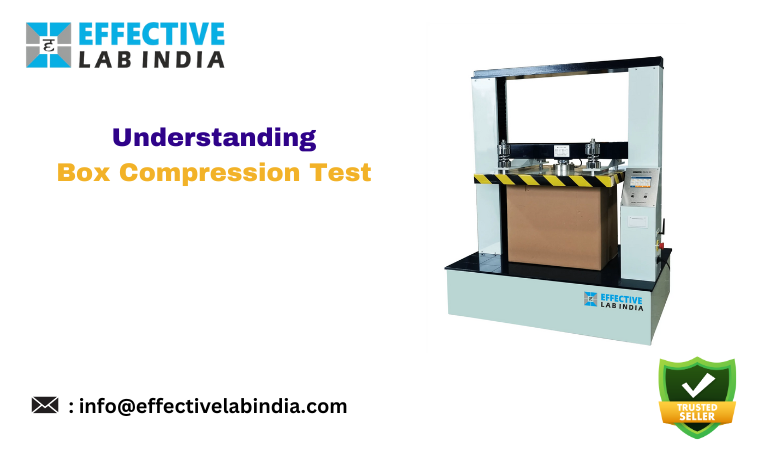Understanding Box Compression Test- Effective Lab India

The box compression test is a crucial procedure used to determine the maximum weight a box can withstand before collapsing under pressure. It is an essential quality control measure employed by manufacturers, distributors, and retailers to ensure the reliability and durability of packaging materials.
What is a Box Compression Test?
In simple terms, the box compression test involves subjecting a box to increasing amounts of pressure until it reaches its breaking point. The test is conducted using specialized equipment that applies force evenly to the top of the box, simulating the conditions it might encounter during stacking or handling in a warehouse or during transit.Equipment Required
To conduct a box compression test, several pieces of equipment are necessary:- Box Compression Testing Machine: This machine applies controlled pressure to the top of the box.
- Load Cell: It measures the amount of force exerted on the box.
- Test Fixture: A fixture that securely holds the box in place during testing.
- Data Acquisition System: This system records and analyzes the test data.
Procedure
- Preparation: Place the box to be tested on the test fixture, ensuring it is properly aligned.
- Calibration: Calibrate the Box compression tester according to the manufacturer’s instructions.
- Test Setup: Attach the load cell to the compression testing machine and position it directly above the box.
- Zeroing: Zero the load cell to eliminate any external factors that may affect the test results.
- Testing: Gradually apply pressure to the top of the box at a controlled rate until it deforms or collapses.
- Recording Data: Record the maximum force exerted on the box before failure occurs.
- Analysis: Analyze the test data to determine the compressive strength of the box.
Interpreting Results
After conducting the box compression test, the obtained data needs to be interpreted accurately. The maximum force endured by the box before failure indicates its compressive strength. Higher compressive strength values imply greater resistance to deformation and collapse, making the packaging more suitable for heavy-duty applications. Different outcomes of the test may include:- Pass: The box withstands the specified pressure without collapsing.
- Fail: The box deforms or collapses before reaching the specified pressure.
Factors Affecting Box Compression Test
Several factors can influence the results of a box compression test, including:- Environmental Factors: Temperature, humidity, and altitude can impact the performance of packaging materials.
- Material Factors: The type of material used, its thickness, and its construction all affect the compressive strength of the box.
Applications of Box Compression Test
The box compression test finds applications in various industries, including:- Food and Beverage: Ensuring the safe transport of perishable goods.
- Pharmaceuticals: Protecting medications and medical supplies during shipping.
- E-commerce: Safeguarding products ordered online during transit.
- Manufacturing: Assessing the quality of packaging materials before distribution
Benefits of Conducting Box Compression Test
Conducting box compression tests offers several benefits:- Quality Assurance: Ensures that packaging materials meet industry standards.
- Cost Reduction: Identifies weak points in packaging design, reducing the risk of product damage and minimizing losses.
- Customer Satisfaction: Ensures that products arrive intact, enhancing customer experience and loyalty.
Limitations
Despite its importance, the box compression test has some limitations:- Static Testing: The test simulates static compression forces and may not accurately reflect the dynamic stresses encountered during transit.
- Material Variability: Variations in material properties can affect test results, necessitating careful consideration during interpretation.
- Single-point Measurement: The test provides a single data point and may not capture the full range of performance characteristics of the packaging material.
Calculating Box Compression Test
The compressive strength of a box can be calculated using the following formula: P=A/F Where:- P = Compressive strength (in pounds per square inch or PSI)
- F = Maximum force exerted on the box (in pounds)
- A = Surface area of the box’s top panel (in square inches)
Example Calculation
Let’s consider an example where a box has a maximum force exerted on it of 1000 pounds and a top panel surface area of 50 square inches. Using the box copression test formula: P=1000/50=20 PSI Therefore, the compressive strength of the box is 20 pounds per square inch.Tips for Accurate Testing
To ensure accurate and reliable test results, follow these tips:- Standardize Testing Conditions: Maintain consistent temperature, humidity, and testing procedures.
- Proper Equipment Calibration: Regularly calibrate testing equipment to ensure accurate measurements.
- Sample Size: Test a representative sample of boxes to account for variability in materials.
- Data Analysis: Thoroughly analyze test data to identify trends and patterns.
- Continuous









